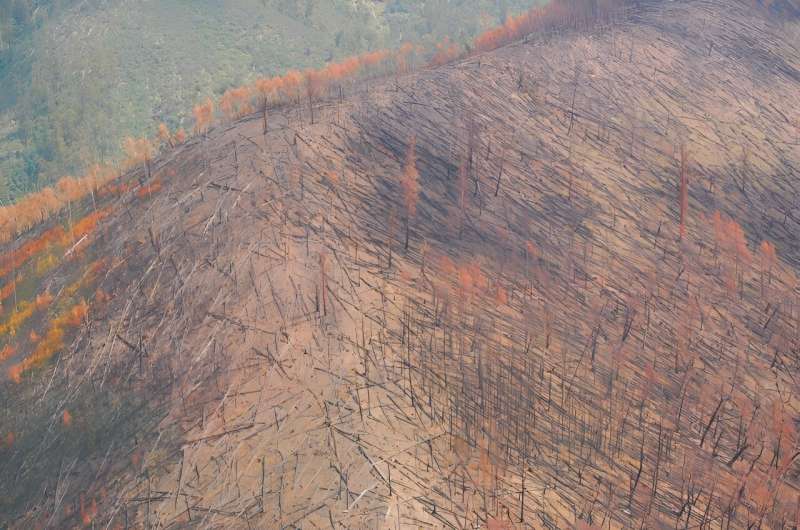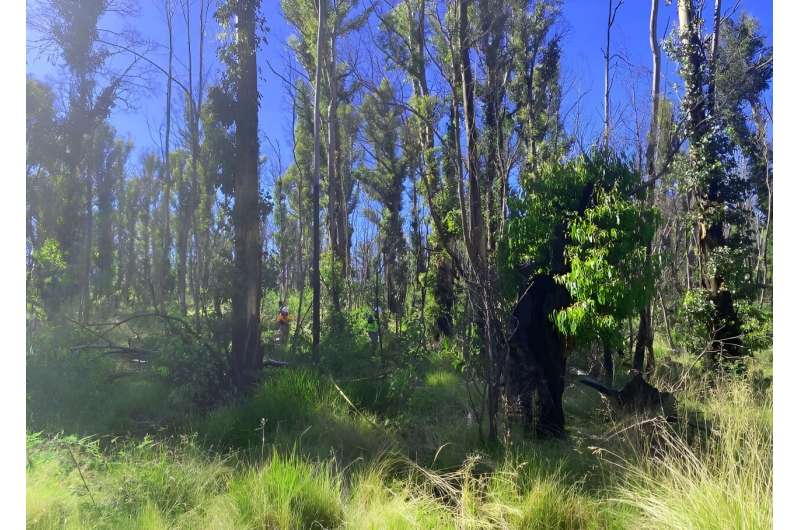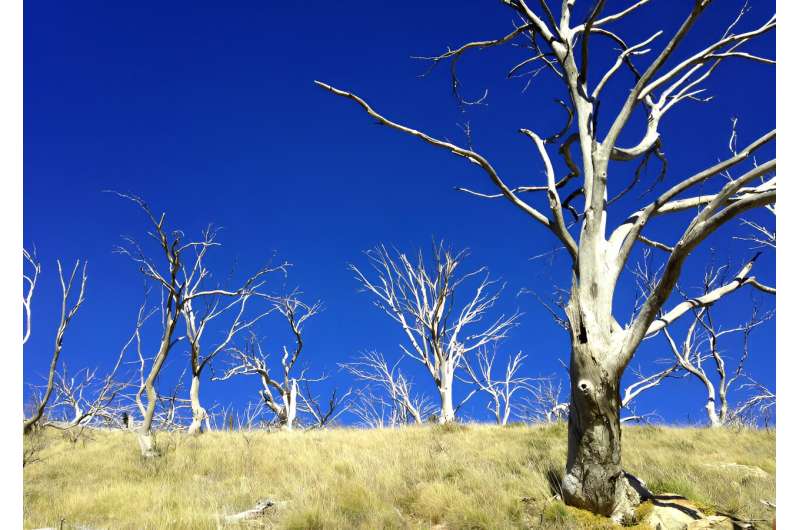This article has been reviewed according to Science X's editorial process and policies. Editors have highlighted the following attributes while ensuring the content's credibility:
fact-checked
peer-reviewed publication
trusted source
proofread
Bushfires are changing the 'hidden' understory in Australian forests

Fire is a natural part of the Australian landscape. But the more frequent fires we've seen recently—particularly the high severity bushfires that consume or scorch the canopies of whole forests—are a major concern to our country's ecosystem health, carbon storage and biodiversity.
We often see devastating footage of those eucalypt forests in flames, but we should also be concerned about the effect of bushfires we can't always see—sometimes below ground.
More to forests than trees
Most of our understanding of the impacts of fires comes from the trees that form the overstory of these forests.
For example, we know that more frequent severe fires lead to the loss of fire-sensitive trees like alpine ash and a decline in otherwise fire-tolerant snow gum forests.
The overstory—the layer of vegetation formed by the tallest trees in the forest that typically receive the most sunlight and form the upper canopy of the forest—is where most of the carbon is stored and where we find the hollows for animals to live in.
While the overstory is important, there is much more to forests than its trees.
The understory—the shorter trees, shrubs, and plants that grow beneath the overstory—is where we find most of the plant diversity.
And the soil beneath that is where the "hidden" understory resides—the understory species' seeds lie dormant in the soil seedbank, sometimes for decades—waiting for their opportunity to germinate.
The soil seedbank is a vital extension of aboveground plant diversity.
It represents the legacy of understory plants which may have died long ago, and act as a source of new growth for future generations.
Think of the soil seedbank as an insurance reserve of plant diversity in the event of something calamitous happening to the living understory plants.
In a world of frequent severe fires, that calamity is becoming a reality.
So what happens to these deeper, darker but important parts of the forests in an extreme bushfire? We have started to answer this question in our recent research published in the journal Fire.

Into the 'hidden' understory
In our two recently published papers, with the other being published in Forest Ecology and Management, our team investigated how the plant understory responds to more frequent, severe fires across a range of forest types.
We looked at the dry shrubby forests at low elevations and the montane forests at high elevations, all the way through to the snow gum forests that fringe Victoria's alpine peaks.
Montane forests have higher precipitation, so the forest generally becomes taller, wetter, darker and more dense—forming the most extensive zone in the Australian Alps.
We found across all of these forest types, there was a shift in plant community composition—both in the living vegetation and the soil seedbank—with more frequent fire.
If we look at the living plants of the understory, more frequent severe fires have led to a decline in plant diversity at the lowest and highest elevations.
But the overall character of understory communities also changes. With more fire, there's a shift towards grassy and herb-dominated understories, particularly at higher elevations—as many shrub species fail to cope with frequent fire.
Mountain beardheath (Acrothamnus hookeri)—a small shrub with white flowers and fleshy red fruit—characteristic of the understory of subalpine woodlands one such species now absent from frequently burnt sites.
In montane and lower-elevation forests, the shrubs that did survive more typically reached reproductive maturity faster, produced seeds that survived in the soil for a long time, and seeds that germinated in response to fire.
Box-leaf Bitter-pea (Daviesia buxifolia) is one of the shrubs that has increased with more frequent fire—and is common in both the living vegetation and soil seedbank.
Each of these adaptations helps these plants survive when fires become more frequent.
Across all forest types, we found a decline in the diversity of the soil seedbank—which suggests that the insurance role the seedbank plays is being eroded by frequent fire.
This erosion in the buffering capacity of soil seed banks points to an increase in reliance on other mechanisms for maintaining plant diversity.
These mechanisms—including post-fire resprouting, or long-distance dispersal from areas protected from fire—favor some species over others, producing a shift in the species that make up understory communities.

The changing character of Australian forests
Our research shows that emerging fire regimes are pushing the very character of our forests—not just the trees, but the shrubs, grasses, herbs, and soil seedbank—into new territory.
These changes in the type and diversity of species shouldn't only be a concern for botanists.
When ecosystems become dominated by new or different kinds of vegetation, there are consequences for the animals that rely on that habitat, and more broadly, consequences for the flammability of these systems—which may lead to more fire—which continues to compound the problem.
So how can we manage this?
Currently, when areas of forests are burned by multiple fires, governments often act to resow these areas with the tree species that have been lost. This usually focuses on species like mountain ash and alpine ash, which are killed by fire.
Our research highlights a possible need to broaden this approach.
With more frequent fire changing the composition of our forests' understory, we may need to include important species that are facing being scorched out of existence by frequent fire.
This is a major restoration undertaking, but one we should not shy away from.
The biggest challenge is collecting enough seed. This would require a multi-pronged approach including harvesting seed from the wild as well as establishing seed orchards for a wide range of species.
Another challenge is the scale of the problem.
A recent study on alpine ash forests alone predicted that an average increase of 110 hectares per year would be burnt before the forest was old enough to produce seed and regenerate.
Given frequent fire erodes understory diversity across multiple forest types, the scale of the restoration challenge is much greater than current efforts to restore any single overstory species.
If we wish our forests to be resilient to future fires, we will have to get used to giving them a helping hand along the way.
More information: Sabine Kasel et al, Short-Interval, High-Severity Wildfire Depletes Diversity of Both Extant Vegetation and Soil Seed Banks in Fire-Tolerant Eucalypt Forests, Fire (2024). DOI: 10.3390/fire7040148
Emily Duivenvoorden et al, Short-interval, high-severity wildfires cause declines in soil seed bank diversity in montane forests of south-eastern Australia, Forest Ecology and Management (2023). DOI: 10.1016/j.foreco.2023.121627
Journal information: Forest Ecology and Management
Provided by University of Melbourne




















